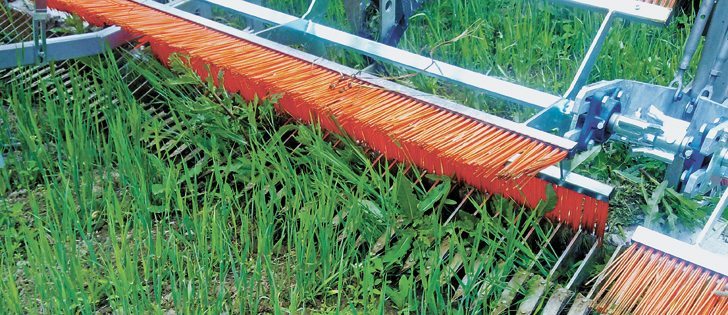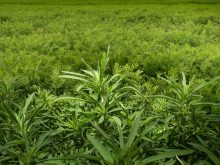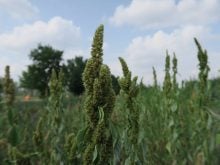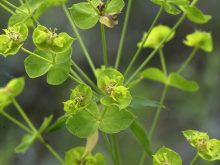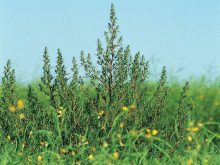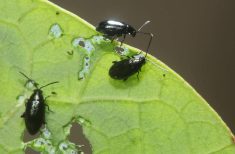According to the Swedish University of Agricultural Sciences:
Herbicide resistant weeds, despite new technologies and recent research, remains a challenge for producers globally. Herbicide resistance in Russian thistle recently turned up in Montana — page 3 of the March 10 edition of The Western Producer. Look for a series of stories in the Production section, beginning in this edition, that look at the issue from a prairie point of view.
Organic farmers and farmers facing herbicide resistance have a new tool that some would call revolutionary.
The CombCut mechanically removes broadleaf weeds from standing cereals without inflicting crop damage.
Read Also

Growing garlic by the thousands in Manitoba
Grower holds a planting party day every fall as a crowd gathers to help put 28,000 plants, and sometimes more, into theground
The term “mechanical weed control” conjures up images of intensive cultivation and the associated soil degradation issues.
However, selectively clipping broadleaf weeds in a standing cereal crop without hurting the crop can go a long way toward breaking weed cycles, and with no risk of soil erosion.
The Swedish-built CombCut weed mower employs sharp little knives that slice the stiff stems of most broadleaf plants, including volunteer canola, while allowing pliable grassy plants to bend and slide through unharmed. It’s like a scythe with a discriminating blade.
At first glance, CombCut looks like a swather with bright orange bristle brushes that sweep the crop and weeds into the fixed position cutter bar. In some respects, it resembles a stripper header.
The cutter bar is fitted with teeth to direct every plant into the straight blade knives. All coarse plant stems are severed or severely damaged by the razors.
Younger, thinner crop stems that offer no resistance pass through unscathed.
The implement normally runs through at 10 km-h, but Swedish researchers say they have had good results all the way up to 22 km-h.
The cutter bar can run at a safe level just below the heads of standing weeds, while running it lower to the ground results in higher rates of weed kill and running right at ground level provides the best rate of weed kill.
However, that may damage to the delicate blades.
The machine runs on wheels, which should prevent a major wreck when run close to the surface.
Timing is critical. The weed mower should be used only when the cereal crop is young and the plants still pliable. The blades will cut more mature cereal crops.
The Swedish University of Agricultural Sciences conducted field trials with the CombCut, reporting a grain yield increase of 76 to 94 percent on fields infested with thistle and docks.
The studies showed a reduction in flower buds of 87 to 100 percent. It’s recommended that CombCut be used before the weeds have a chance to go to seed. They point out that using a weed clipper instead of tillage leaves the weed seed bank undisturbed.
Above ground dry plant matter for weeds was reduced 68 to 89 percent, while underground dry root material of the weeds was reduced by 66 to 79 percent.
Even if the weeds aren’t killed outright, they are damaged to the extent that the crop will grow and out-compete them.
Not only does this reduce herbicide use, but it also lets a producer kill weeds when wet weather prevents spraying.
Colin Tanner, whose family organically farms 800 acres near Pense, Sask., and whose company, SonTanner Sales, is the CombCut dealer for the Prairies, said they imported a six metre CombCut last spring as a way to clean up thistles without chemicals or cultivation.
“We tried it on 280 acres of cereals and 40 acres of fall rye. I was going to do test strips, but we had such a terrible stand because of the drought that it wouldn’t have been valid,” Tanner said.
“But visually, the difference was night and day between the CombCut acres and the acres I left untouched.
“I’m going to conduct field trials this year. The University of Manitoba and the Crop Development Center at the University of Saskatchewan both have CombCuts, and they also plan on conducting field trials in 2016.”
The CombCut reel is hydraulically driven. It mounts to a three-point hitch at the front or back of the tractor. There is no draught requirement and no need for a high horsepower tractor.
Tanner has about a dozen of the weed mowers on order with a handful already sold.
The six metre CombCut has 150 blades, weighs 1,900 pounds and sells for about $36,000.
The eight metre model has 210 blades, weighs 2,300 lb. and sells for about $44,000.
For more information, contact Tanner at 306-546-5686 or visit www.justcommonsense.eu.
Contact ron.lyseng@producer.com
- Crop timing is by far the most important factor.
- Use CombCut when the physical difference between weed and crop culture is most significant.
- Start as early in the season as possible, before the crop starts to form firm straws.
- Comb through the flag leaves of the crop. Before the flag leaves are formed, the risk of harming the crop is minimal.
- “Cut the weed before the seed.”
- For best effect, cut thistle when it has six to eight leaves. If necessary, repeat the cutting after one to four weeks.




